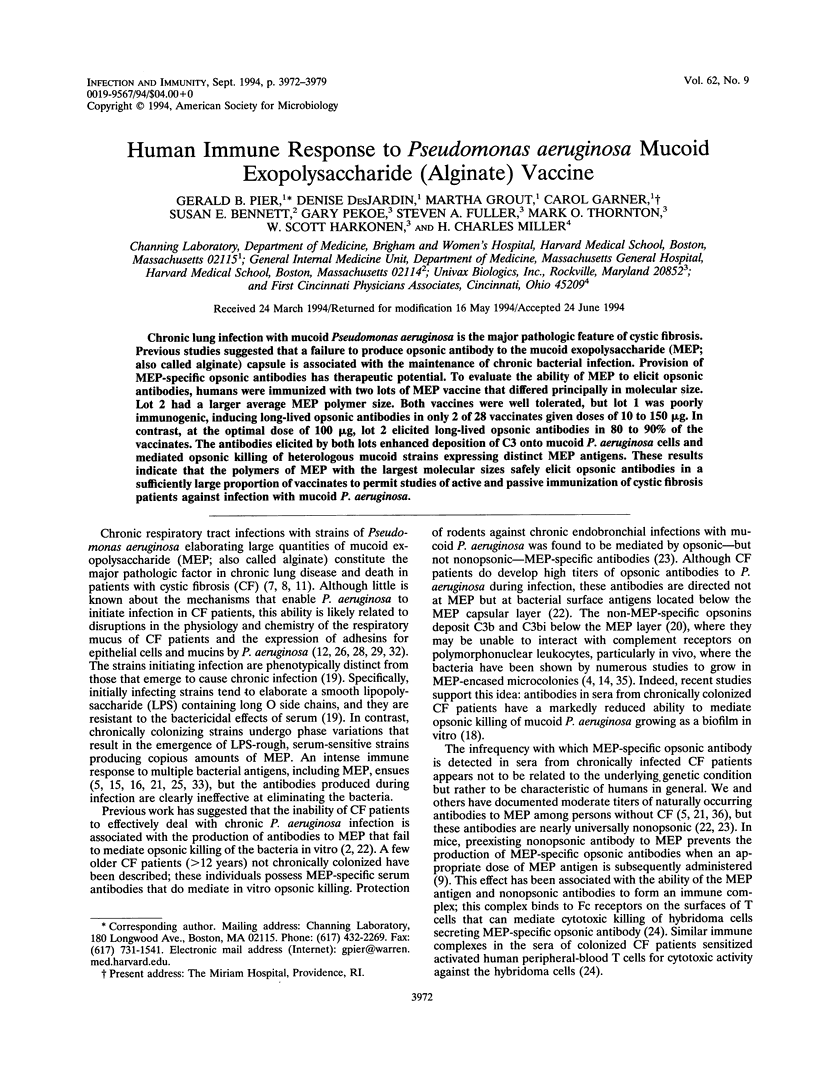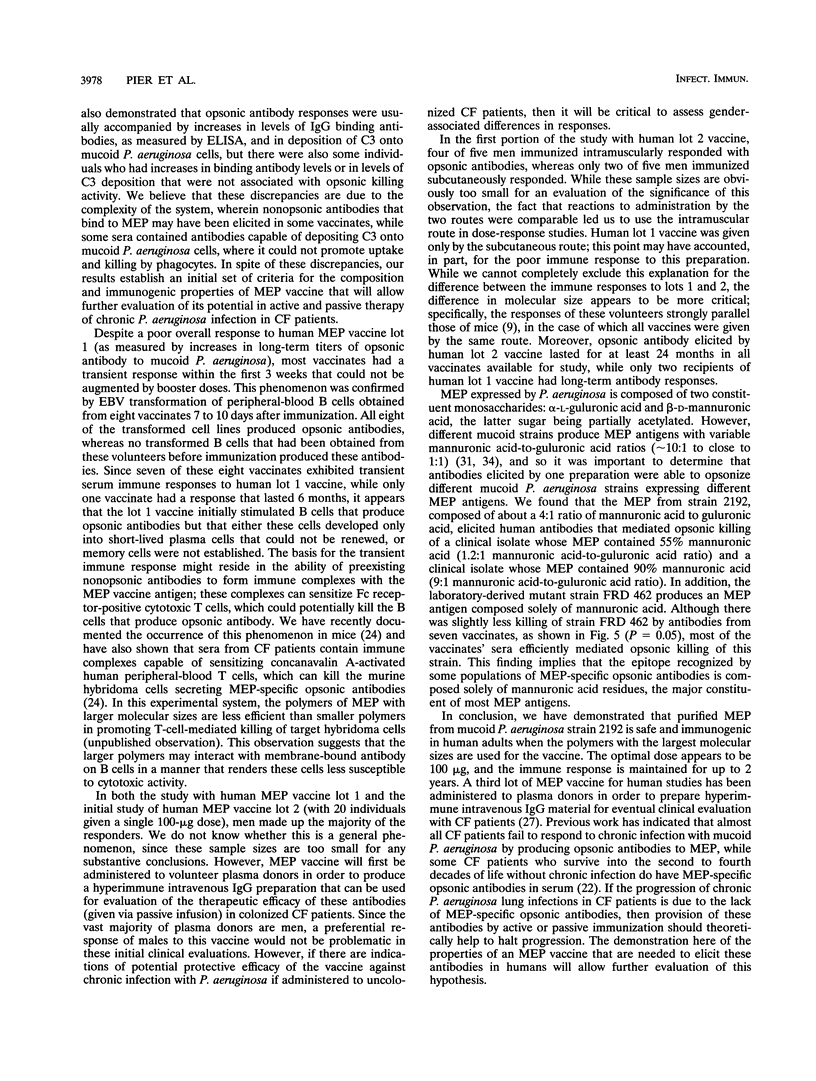Abstract
Chronic lung infection with mucoid Pseudomonas aeruginosa is the major pathologic feature of cystic fibrosis. Previous studies suggested that a failure to produce opsonic antibody to the mucoid exopolysaccharide (MEP; also called alginate) capsule is associated with the maintenance of chronic bacterial infection. Provision of MEP-specific opsonic antibodies has therapeutic potential. To evaluate the ability of MEP to elicit opsonic antibodies, humans were immunized with two lots of MEP vaccine that differed principally in molecular size. Lot 2 had a larger average MEP polymer size. Both vaccines were well tolerated, but lot 1 was poorly immunogenic, inducing long-lived opsonic antibodies in only 2 of 28 vaccinates given doses of 10 to 150 micrograms. In contrast, at the optimal dose of 100 micrograms, lot 2 elicited long-lived opsonic antibodies in 80 to 90% of the vaccinates. The antibodies elicited by both lots enhanced deposition of C3 onto mucoid P. aeruginosa cells and mediated opsonic killing of heterologous mucoid strains expressing distinct MEP antigens. These results indicate that the polymers of MEP with the largest molecular sizes safely elicit opsonic antibodies in a sufficiently large proportion of vaccinates to permit studies of active and passive immunization of cystic fibrosis patients against infection with mucoid P. aeruginosa.
Full text
PDF







Selected References
These references are in PubMed. This may not be the complete list of references from this article.
- Ambrosino D. M., Delaney N. R., Shamberger R. C. Human polysaccharide-specific B cells are responsive to pokeweed mitogen and IL-6. J Immunol. 1990 Feb 15;144(4):1221–1226. [PubMed] [Google Scholar]
- Ames P., DesJardins D., Pier G. B. Opsonophagocytic killing activity of rabbit antibody to Pseudomonas aeruginosa mucoid exopolysaccharide. Infect Immun. 1985 Aug;49(2):281–285. doi: 10.1128/iai.49.2.281-285.1985. [DOI] [PMC free article] [PubMed] [Google Scholar]
- Baker C. J., Edwards M. S., Kasper D. L. Immunogenicity of polysaccharides from type III, group B Streptococcus. J Clin Invest. 1978 Apr;61(4):1107–1110. doi: 10.1172/JCI109011. [DOI] [PMC free article] [PubMed] [Google Scholar]
- Baltimore R. S., Christie C. D., Smith G. J. Immunohistopathologic localization of Pseudomonas aeruginosa in lungs from patients with cystic fibrosis. Implications for the pathogenesis of progressive lung deterioration. Am Rev Respir Dis. 1989 Dec;140(6):1650–1661. doi: 10.1164/ajrccm/140.6.1650. [DOI] [PubMed] [Google Scholar]
- Bryan L. E., Kureishi A., Rabin H. R. Detection of antibodies to Pseudomonas aeruginosa alginate extracellular polysaccharide in animals and cystic fibrosis patients by enzyme-linked immunosorbent assay. J Clin Microbiol. 1983 Aug;18(2):276–282. doi: 10.1128/jcm.18.2.276-282.1983. [DOI] [PMC free article] [PubMed] [Google Scholar]
- Chitnis C. E., Ohman D. E. Cloning of Pseudomonas aeruginosa algG, which controls alginate structure. J Bacteriol. 1990 Jun;172(6):2894–2900. doi: 10.1128/jb.172.6.2894-2900.1990. [DOI] [PMC free article] [PubMed] [Google Scholar]
- Fick R. B., Jr Pathogenesis of the pseudomonas lung lesion in cystic fibrosis. Chest. 1989 Jul;96(1):158–164. doi: 10.1378/chest.96.1.158. [DOI] [PubMed] [Google Scholar]
- Fick R. B., Jr Pathogenetic mechanisms in cystic fibrosis lung disease: a paradigm for inflammatory airways disease. J Lab Clin Med. 1993 May;121(5):632–634. [PubMed] [Google Scholar]
- Garner C. V., DesJardins D., Pier G. B. Immunogenic properties of Pseudomonas aeruginosa mucoid exopolysaccharide. Infect Immun. 1990 Jun;58(6):1835–1842. doi: 10.1128/iai.58.6.1835-1842.1990. [DOI] [PMC free article] [PubMed] [Google Scholar]
- Greenberg D. P., Vadheim C. M., Bordenave N., Ziontz L., Christenson P., Waterman S. H., Ward J. I. Protective efficacy of Haemophilus influenzae type b polysaccharide and conjugate vaccines in children 18 months of age and older. JAMA. 1991 Feb 27;265(8):987–992. [PubMed] [Google Scholar]
- Houdret N., Ramphal R., Scharfman A., Perini J. M., Filliat M., Lamblin G., Roussel P. Evidence for the in vivo degradation of human respiratory mucins during Pseudomonas aeruginosa infection. Biochim Biophys Acta. 1989 Jul 21;992(1):96–105. doi: 10.1016/0304-4165(89)90055-x. [DOI] [PubMed] [Google Scholar]
- Høiby N., Koch C. Cystic fibrosis. 1. Pseudomonas aeruginosa infection in cystic fibrosis and its management. Thorax. 1990 Nov;45(11):881–884. doi: 10.1136/thx.45.11.881. [DOI] [PMC free article] [PubMed] [Google Scholar]
- Indiveri F., Huddlestone J., Pellegrino M. A., Ferrone S. Isolation of human T lymphocytes: comparison between nylon wool filtration and rosetting with neuraminidase (VCN) and 2-aminoethylisothiouronium bromide (AET)-treated sheep red blood cells (SRBC). J Immunol Methods. 1980;34(2):107–115. doi: 10.1016/0022-1759(80)90164-7. [DOI] [PubMed] [Google Scholar]
- Lam J., Chan R., Lam K., Costerton J. W. Production of mucoid microcolonies by Pseudomonas aeruginosa within infected lungs in cystic fibrosis. Infect Immun. 1980 May;28(2):546–556. doi: 10.1128/iai.28.2.546-556.1980. [DOI] [PMC free article] [PubMed] [Google Scholar]
- Pedersen S. S., Høiby N., Espersen F., Koch C. Role of alginate in infection with mucoid Pseudomonas aeruginosa in cystic fibrosis. Thorax. 1992 Jan;47(1):6–13. doi: 10.1136/thx.47.1.6. [DOI] [PMC free article] [PubMed] [Google Scholar]
- Pier G. B., Desjardins D., Aguilar T., Barnard M., Speert D. P. Polysaccharide surface antigens expressed by nonmucoid isolates of Pseudomonas aeruginosa from cystic fibrosis patients. J Clin Microbiol. 1986 Aug;24(2):189–196. doi: 10.1128/jcm.24.2.189-196.1986. [DOI] [PMC free article] [PubMed] [Google Scholar]
- Pier G. B., Grout M., Desjardins D. Complement deposition by antibodies to Pseudomonas aeruginosa mucoid exopolysaccharide (MEP) and by non-MEP specific opsonins. J Immunol. 1991 Sep 15;147(6):1869–1876. [PubMed] [Google Scholar]
- Pier G. B., Matthews W. J., Jr, Eardley D. D. Immunochemical characterization of the mucoid exopolysaccharide of Pseudomonas aeruginosa. J Infect Dis. 1983 Mar;147(3):494–503. doi: 10.1093/infdis/147.3.494. [DOI] [PubMed] [Google Scholar]
- Pier G. B. Safety and immunogenicity of high molecular weight polysaccharide vaccine from immunotype 1 Pseudomonas aeruginosa. J Clin Invest. 1982 Feb;69(2):303–308. doi: 10.1172/JCI110453. [DOI] [PMC free article] [PubMed] [Google Scholar]
- Pier G. B., Saunders J. M., Ames P., Edwards M. S., Auerbach H., Goldfarb J., Speert D. P., Hurwitch S. Opsonophagocytic killing antibody to Pseudomonas aeruginosa mucoid exopolysaccharide in older noncolonized patients with cystic fibrosis. N Engl J Med. 1987 Sep 24;317(13):793–798. doi: 10.1056/NEJM198709243171303. [DOI] [PubMed] [Google Scholar]
- Pier G. B., Small G. J., Warren H. B. Protection against mucoid Pseudomonas aeruginosa in rodent models of endobronchial infections. Science. 1990 Aug 3;249(4968):537–540. doi: 10.1126/science.2116663. [DOI] [PubMed] [Google Scholar]
- Pier G. B., Takeda S., Grout M., Markham R. B. Immune complexes from immunized mice and infected cystic fibrosis patients mediate murine and human T cell killing of hybridomas producing protective, opsonic antibody to Pseudomonas aeruginosa. J Clin Invest. 1993 Mar;91(3):1079–1087. doi: 10.1172/JCI116265. [DOI] [PMC free article] [PubMed] [Google Scholar]
- Pressler T., Pandey J. P., Espersen F., Pedersen S. S., Fomsgaard A., Koch C., Høiby N. Immunoglobulin allotypes and IgG subclass antibody response to Pseudomonas aeruginosa antigens in chronically infected cystic fibrosis patients. Clin Exp Immunol. 1992 Nov;90(2):209–214. [PMC free article] [PubMed] [Google Scholar]
- Prince A. Adhesins and receptors of Pseudomonas aeruginosa associated with infection of the respiratory tract. Microb Pathog. 1992 Oct;13(4):251–260. doi: 10.1016/0882-4010(92)90035-m. [DOI] [PubMed] [Google Scholar]
- Ramphal R., Vishwanath S. Why is Pseudomonas the colonizer and why does it persist? Infection. 1987 Jul-Aug;15(4):281–287. doi: 10.1007/BF01644139. [DOI] [PubMed] [Google Scholar]
- Russell N. J., Gacesa P. Chemistry and biology of the alginate of mucoid strains of Pseudomonas aeruginosa in cystic fibrosis. Mol Aspects Med. 1988;10(1):1–91. doi: 10.1016/0098-2997(88)90002-7. [DOI] [PubMed] [Google Scholar]
- Saiman L., Ishimoto K., Lory S., Prince A. The effect of piliation and exoproduct expression on the adherence of Pseudomonas aeruginosa to respiratory epithelial monolayers. J Infect Dis. 1990 Mar;161(3):541–548. doi: 10.1093/infdis/161.3.541. [DOI] [PubMed] [Google Scholar]
- Shand G. H., Pedersen S. S., Brown M. R., Høiby N. Serum antibodies to Pseudomonas aeruginosa outer-membrane proteins and iron-regulated membrane proteins at different stages of chronic cystic fibrosis lung infection. J Med Microbiol. 1991 Apr;34(4):203–212. doi: 10.1099/00222615-34-4-203. [DOI] [PubMed] [Google Scholar]
- Sherbrock-Cox V., Russell N. J., Gacesa P. The purification and chemical characterisation of the alginate present in extracellular material produced by mucoid strains of Pseudomonas aeruginosa. Carbohydr Res. 1984 Dec 15;135(1):147–154. doi: 10.1016/0008-6215(84)85012-0. [DOI] [PubMed] [Google Scholar]
- Speert D. P., Dimmick J. E., Pier G. B., Saunders J. M., Hancock R. E., Kelly N. An immunohistological evaluation of Pseudomonas aeruginosa pulmonary infection in two patients with cystic fibrosis. Pediatr Res. 1987 Dec;22(6):743–747. doi: 10.1203/00006450-198712000-00026. [DOI] [PubMed] [Google Scholar]
- Speert D. P., Lawton D., Mutharia L. M. Antibody to Pseudomonas aeruginosa mucoid exopolysaccharide and to sodium alginate in cystic fibrosis serum. Pediatr Res. 1984 May;18(5):431–433. doi: 10.1203/00006450-198405000-00008. [DOI] [PubMed] [Google Scholar]
- Sugden B., Phelps M., Domoradzki J. Epstein-Barr virus DNA is amplified in transformed lymphocytes. J Virol. 1979 Sep;31(3):590–595. doi: 10.1128/jvi.31.3.590-595.1979. [DOI] [PMC free article] [PubMed] [Google Scholar]


